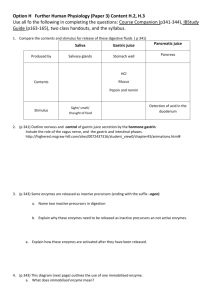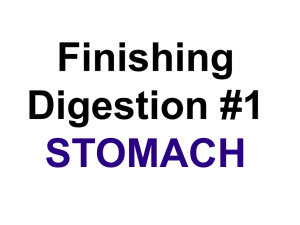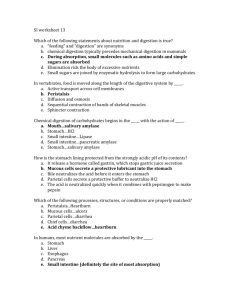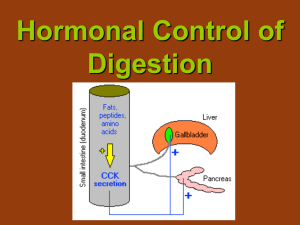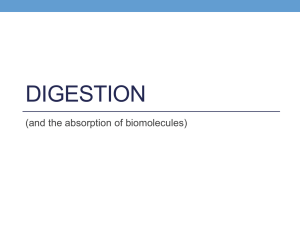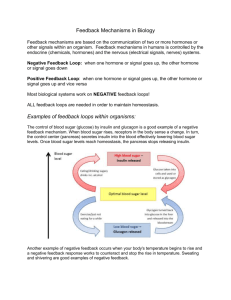Digestive Enzymes
advertisement
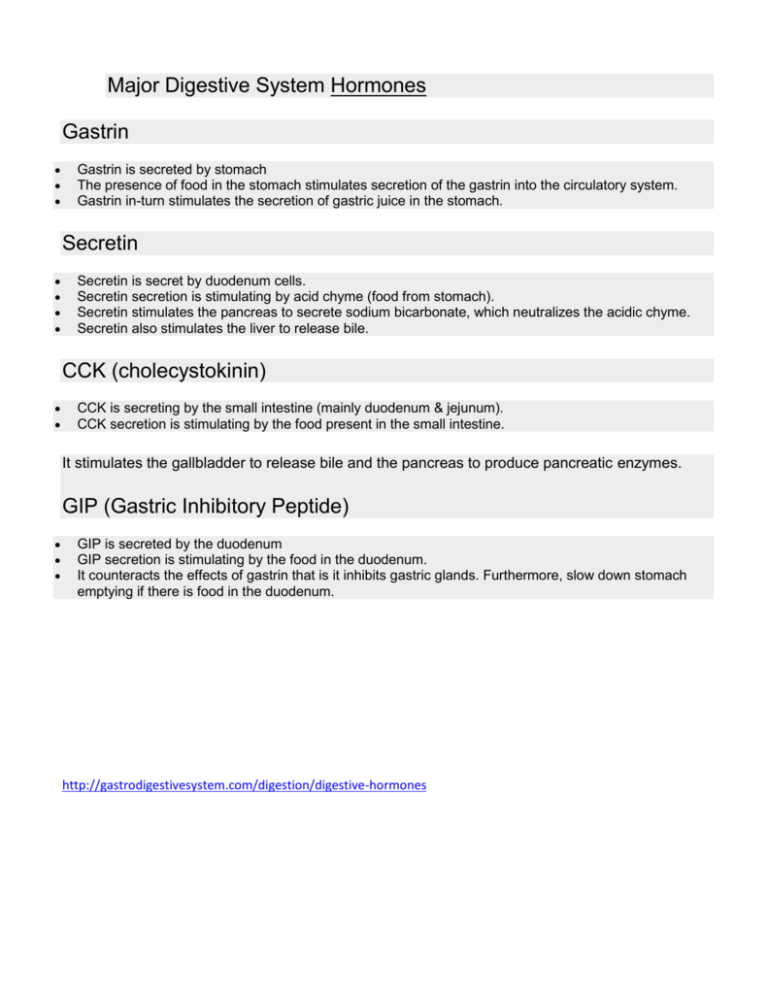
Major Digestive System Hormones Gastrin Gastrin is secreted by stomach The presence of food in the stomach stimulates secretion of the gastrin into the circulatory system. Gastrin in-turn stimulates the secretion of gastric juice in the stomach. Secretin Secretin is secret by duodenum cells. Secretin secretion is stimulating by acid chyme (food from stomach). Secretin stimulates the pancreas to secrete sodium bicarbonate, which neutralizes the acidic chyme. Secretin also stimulates the liver to release bile. CCK (cholecystokinin) CCK is secreting by the small intestine (mainly duodenum & jejunum). CCK secretion is stimulating by the food present in the small intestine. It stimulates the gallbladder to release bile and the pancreas to produce pancreatic enzymes. GIP (Gastric Inhibitory Peptide) GIP is secreted by the duodenum GIP secretion is stimulating by the food in the duodenum. It counteracts the effects of gastrin that is it inhibits gastric glands. Furthermore, slow down stomach emptying if there is food in the duodenum. http://gastrodigestivesystem.com/digestion/digestive-hormones STOMACH The enzymes that are secreted in the stomach are called gastric enzymes. The stomach plays a major role in digestion, both in a mechanical sense by mixing and crushing the food, and also in an enzymatic sense, by digesting it. There are other secretions by the stomach that are necessary to facilitate digestion, too. Pepsinogen is the main gastric enzyme. It is produced by the stomach cells called "chief cells" in its inactive form pepsinogen, Pepsinogen is then activated by the stomach acid into its active form, pepsin. Pepsin breaks down the protein in the food into smaller particles, such as peptide fragments and amino acids. Protein digestion, therefore, first starts in the stomach, unlike carbohydrate and lipids, which start their digestion in the mouth. Hydrochloric acid (HCl): This is in essence positively charged hydrogen atoms (H), or in layterms stomach acid, and is produced by the cells of the stomach called parietal cells. HCl mainly functions to denature the proteins ingested, to destroy any bacteria or virus that remains in the food, and also to activate pepsinogen into pepsin. Mucin: The stomach has a priority to destroy the bacteria and viruses using its highly acidic environment but also has a duty to protect its own lining from its acid. The way that the stomach achieves this is by secreting mucin and bicarbonate via its mucous cells, and also by having a rapid cell turn-over. Gastrin: This is an important hormone produced by the "G cells" of the stomach. G cells produce gastrin in response to stomach stretching occurring after food enters it, and also after stomach exposure to protein. Gastrin is an endocrine hormone and therefore enters the bloodstream and eventually returns to the stomach where it stimulates parietal cells to produce hydrochloric acid (HCl) and Intrinsic factor (IF). http://en.wikipedia.org/wiki/Digestive_enzyme Digestive Enzymes Digestive Enzymes Have you ever thought what happens to the food after you have taken it into your mouth? How those big steak pieces end up into small amino acids.....how those rice ends up giving you glucose? How those fatty food you eat end up into fatty acid and glycerol?...and where do all the extra things go? So today I’m going to tell you everything about digestion.... from the time you put your food into you mouth till the time you go defecate and throw the extra stuff out of your body!! MOUTH In the mouth, the food is digested physically (mechanically) by your teeth. The salivary glands in your mouth produce saliva beginning the chemical digestion. Saliva contains an enzyme called salivary amylase. Salivary amylase keeps the pH in the mouth basic. Salivary amylase will digest starch in your food to maltose, which will later get digested to glucose in the Duodenum. Salivary Amylase Starch -------------> Maltose The food is mixed with the saliva and is now called a bolus. The bolus travels down the esophagus by peristalsis movement. A wave of contraction is made on the walls of the esophagus just above the food bolus, this pushes the bolus down, another wave is made and by these waves the food is passed into the stomach through the cardiac sphincter. The cardiac sphincter also prevents the regurgitation of food from the stomach back into the esophagus. STOMACH When proteins are detected in the stomach, the hormone gastrin is released into the bloodstream. This hormone causes the gastric glands in the lining of the stomach wall to produce gastric juice. Gastric juice is an acidic juice (pH 1 - 3). Its main components are HCl and pepsinogen. HCl - HCl (Hydrochloric Acid) keeps the stomach pH acidic. As HCl is a strong acid, it will kill most of the bacteria present in the food. It has another main function. That is to convert Pepsinogen into Pepsin. Pepsin is an enzyme that beginning the breakdown of protein. Pepsinogen --------> Pepsin Pepsinogen - Pepsinogen is activated by HCl into Pepsin. Pepsin digests other proteins the food to smaller peptides fragments. present in After all the digestion that takes place in the stomach, the remaining food now called as chyme. The chyme is passed through the pyloric sphincter into the first part of the small intestine called the duodenum. DUODENUM (part of the small intestine) There are also 3 things secreted in the Duodenum: Bile, pancreatic enzymes, intestinal enzymes Bile - Bile is secreted by the gall bladder. After being secreted by the gall bladder it travels in the bile duct which opens into the duodenum. Bile helps to emusify fats, that is they break them down into small globules which are easily digested by the enzyme lipase that comes from the pancreas. Pancreatic enzymes - Secreted by the pancreas, it travels in the pancreatic duct which opens into the duodenum. There are enzymes continue to help breakdown carbohydrate, protein and fats. Lipase – this enzyme is part of the pancreatic juice and acts on fats converting them into fatty acids & glycerol. Pancreatic Amylase – completes the digestion of starch that started in the mouth. Trypsin- continues the digestion of proteins. The pancreas also secretes bicarbonate to neutralize the acidic chime coming from the stomach. Intestinal Enzymes - secreted by wall of the small intestine. Some of those enzymes are: Maltase - Digests Maltose to glucose. Sucrase - Digests sucrose into glucose and fructose. Lactase - Digests lactose into glucose. The last sections of the small intestine- JEJUNUM and ILIUM The walls of the jejunum and ilium are made up of fingerlike projections known as villi. Villi are made of up microvilli. Therefore there is a very large surface area. The main function here is to absorb all the products of digestion, the tiny molecules (nutrients). The villi contain large numbers of capillaries which take the nutrients and deliver them all over the body through the circulatory system. LARGE INTESTINE The large intestine is mainly responsible for storing waste, reclaiming water, maintaining the water balance, and absorbing some vitamins, such as vitamin K. Its primary purpose is to extract water from the feces (waste). Anus The feces are passed along from the rectum into the anal canal and they are then eliminated out of the body via the anus. Edited from http://www.biology-online.org/articles/digestive_enzymes.html
